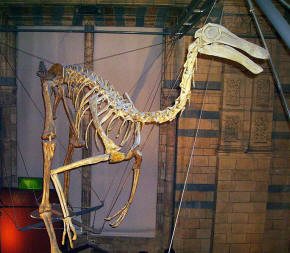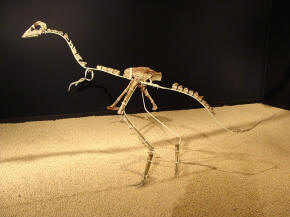Old Earth Ministries Online Dinosaur Curriculum
Free online curriculum for homeschools and private schools
From Old Earth Ministries (We Believe in an Old Earth...and God!)
NOTE: If you found this page through a search engine, please visit the intro page first.
Lesson 27 - Gallimimus
Gallimimus (meaning "chicken or rooster mimic") is a genus of ornithomimid dinosaur from the late Cretaceous period (Maastrichtian stage) Nemegt Formation of Mongolia. With individuals as long as 8 metres (26 ft), it was one of the largest ornithomimosaurs. Gallimimus is known from multiple individuals, ranging from juvenile (about 0.5 metres tall at the hip) to adult (about 2 metres tall at the hip).
Discovery
The fossil
remains of this dinosaur were discovered in the early 1970s in the
Gobi
Desert of Mongolia. In 1972, it was named by
paleontologists
Rinchen Barsbold,
Halszka Osmólska, and
Ewa Roniewicz. The only known species is
Gallimimus bullatus. A supposed second species,
"Gallimimus mongoliensis",
has never been formally referred to this genus. A recent reanalysis of the
nearly complete skeleton of Gallimimus
mongoliensis concluded that it is not a species
of Gallimimus but
may represent a new, currently unnamed ornithomimid genus.
Description
Gallimimus was rather ostrich-like, with a small head, large eyes, a long neck, short arms, long legs, and a long tail. A diagnostic character of Gallimimus is a distinctly short 'hand' relative to the humerus length, when compared to other ornithomimids.
Gallimimus
Quick Facts
Length: 26 Ft
Height: 6.5 Ft (at hips)
Weight: 500 lbs
Date Range: 70 Ma, Maastrichtian Age, Cretaceous Period
| Scientific classification | |
|---|---|
| Kingdom: | Animalia |
| Phylum: | Chordata |
| Class: | Reptilia |
| Superorder: | Dinosauria |
| Order: | Saurischia |
| Suborder: | Theropoda |
| Family: | Ornithomimidae |
| Genus: |
Gallimimus |
| Species: | Gallimimus bullatus |

